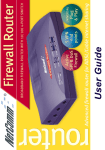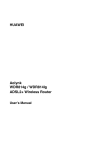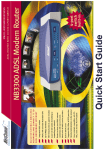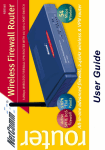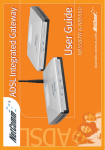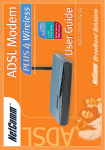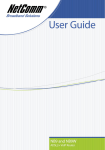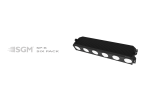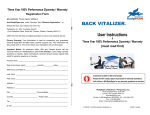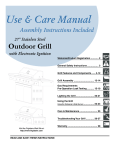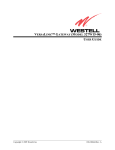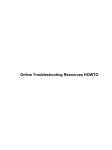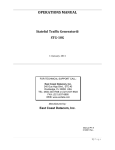Download Broadband Switch Router - EUSSO Technologies, Inc.
Transcript
Broadband Switch Router User Guide Broadband Switch Router User Guide Manufacturer’s Disclaimer State The information in this document is subject to change without notice and does not represent a commitment on the part of vendor. No warranty or representation, either expressed or implied, is made with respect to the quality, accuracy or fitness for any particular prupose of this document. The manufacturer reserves the right to make change to the content of this document and/or the products associated with it at any time without obligation to notify any person or organization. In no event will the manufacturer be liable for direct, indirect, special, incidental or consequential damages arising out of the use or inability to use this product or documentation, even if advised of the possibility of such damages. This document contains materials protected by copyright. All rights are reserved. No part of this manual may be reproduced or transmitted in any form, by any means or for any purpose without expressed written consent of its authors. Product names appearing in this document are mentioned for identification purchases only. All trademarks, product names or brand names appearing in this document are registered property of their respective owners. Broadband Switch Router User Guide Table of Contents MANUFACTURER’S DISCLAIMER STATE..................................................................................................... TABLE OF CONTENTS ........................................................................................................................................ INTRODUCTION................................................................................................................................................. 1 CHAPTER 1: GETTING TO KNOW YOUR BROADBAND SWITCH ROUTER ...................................... 3 1-1 ABOUT THE BROADBAND SWITCH ROUTER .................................................................................................. 3 1-2 CONTENTS OF THE BROADBAND SWITCH ROUTER PACKAGE ........................................................................ 3 1-3 FEATURES OF THE BROADBAND SWITCH ROUTER......................................................................................... 3 CHAPTER 2: HARDWARE INSTALLATION & SETUP ............................................................................... 5 2-1 REAR PANEL & CONNECTIONS...................................................................................................................... 5 2-2 FRONT PANEL LEDS ..................................................................................................................................... 5 2-3 SYSTEM REQUIREMENTS AND SETUP ............................................................................................................ 6 CHAPTER 3: INTERNET ACCESS................................................................................................................. 12 3-1 PREPARE YOUR NETWORK INFORMATION .................................................................................................... 12 3-2 WEB-BASED USER INTERFACE .................................................................................................................... 12 3-3 INITIAL CONFIGURATION – SETUP............................................................................................................... 13 CHAPTER 4: ADVANCED APPLICATIONS ................................................................................................. 15 4-1 DHCP CONFIGURATION .............................................................................................................................. 15 4-2 ACCESS CONTROL ....................................................................................................................................... 15 4-3 VIRTUAL SERVER SETTINGS ........................................................................................................................ 17 4-4 DMZ HOST ................................................................................................................................................. 19 4-5 SPECIAL APPLICATIONS ............................................................................................................................... 20 4-6 DEVICE ADMINISTRATION SETTINGS........................................................................................................... 21 4-7 STATUS MONITOR ....................................................................................................................................... 22 4-8 DYNAMIC ROUTING .................................................................................................................................... 23 4-9 STATIC ROUTING ......................................................................................................................................... 24 4-10 LOG .......................................................................................................................................................... 25 4-11 DDNS....................................................................................................................................................... 27 CHAPTER 5: MACINTOSH SETUP ............................................................................................................... 29 5-1 HARDWARE CONNECTIONS ......................................................................................................................... 29 5-2 COMPUTER NETWORK CONFIGURATION ..................................................................................................... 29 Broadband Switch Router User Guide 5-3 BROADBAND SWITCH ROUTER CONFIGURATION ........................................................................................ 30 5-4 ADDING BROADBAND SWITCH ROUTER TO EXISTING NETWORK................................................................ 30 CHAPTER 6: TROUBLE SHOOTING............................................................................................................ 32 HARDWARE ....................................................................................................................................................... 32 CLIENT SIDE (COMPUTERS)............................................................................................................................... 33 APPENDIX A: FREQUENTLY ASKED QUESTIONS .................................................................................. 35 APPENDIX B: TECHNICAL SPECIFICATIONS.......................................................................................... 37 APPENDIX C: GLOSSARY .............................................................................................................................. 38 Broadband Switch Router User Guide Introduction Congratulations on purchasing this Broadband Switch Router device. This device has been specifically designed to provide Local Area Network (LAN) users with multiple access to the Internet at the cost of a single public IP Address. Connections can be made via Cable or ADSL modems allowing secure and high-speed Internet access. Firewall protection ensures that incoming data packets are monitored and server requests are filtered. This Broadband Switch Router device provides the most cost-effective method for multiple network users to access the Internet using Cable or ADSL. With built-in NAT, this device not only provides natural Internet firewall, protecting your network from access by outside users but also extends LAN connection. This wireless Router allows up to 253 users on the Ethernet LAN simultaneously but makes IP configuration simple and easy. Configured as a DHCP server, the Broadband Switch Router assigns an IP Address to every connected PC on Ethernet LAN automatically. Also, DHCP client helps WAN port to get IP address dynamically assigned by ISP. Unlike other typical routers which share only 10Mbps over all of their connections, this Broadband Switch Router is equipped with a blazing 4-port 10M/100Mbps auto-sensing switch, dedicating a full 100Mbps to each and every connected PC. Not only will all of your PCs be able to enjoy lightning-fast Broadband Internet connections, but they will also be able to share internal network data ten times faster than the Broadband Internet speed. With a web-based UI (User Interface), this Broadband Switch Router is easy to setup and maintain. All functions can be configured with this exclusive, easy and friendly User Interface via web browsers such as Netscape Communicator and Internet Explorer. About this Guide This guide contains information about installing and configuring your Broadband Switch Router. It is designed to guide users through the correct setup procedures for appropriate hardware installation and basic configuration. Later, it shows how to complete advanced configurations to get the best operating performance from this Broadband Switch Router. Chapter 1: Get to know your Broadband Switch Router This chapter describes the package contents and provides a list of features and applications illustrations of the Broadband Switch Router. Chapter 2: Hardware Installation & Setup This chapter describes the steps for hardware installation of the Broadband Switch Router. -1- Broadband Switch Router User Guide Chapter 3: Internet Access This chapter describes the steps for basic configuration and start up of the Broadband Switch Router. Chapter 4: Advanced Applications This chapter describes how to configure advanced functions in order to get the most from your Broadband Switch Router. Chapter 5: Macintosh Setup This Chapter provides instructions on how to set up your Macintosh computers in your network. Chapter 6: Trouble Shooting This chapter describes potential problems you may run into and the suggested remedies. Conventions The following explains the conventions used throughout this document. Italics New words, terms, or special emphasis. your Broadband Switch Router. E.g. Getting to know “Boldface” Buttons, checkboxes, or items that you can select from screens, menus, or dialog boxes. E.g. Click “OK” to restart Boldface Italics Items in Bold Italics are samples only and you should enter other names, numbers, or words to substitute. -2- Broadband Switch Router User Guide Chapter 1: Getting to know your Broadband Switch Router This chapter describes the package contents and provides a list of features and the applications illustrations of the Broadband Switch Router. 1-1 About The Broadband Switch Router Broadband Switch Router uses the NAT protocol and proprietary software that provides Internet connections for up to 253 computers via a single ISP account, thereby maximizing network Internet connection utilization. Moreover, all PCs on LAN can share files, printers and other network resource at a blazing speed. Ethernet / Fast Ethernet Ethernet is the most widely-used network access method, especially in local area network (LAN). It is defined by the IEEE as 802.3 standard. Normally, Ethernet is a shared media LAN. All stations on the segment share the total bandwidth, which could be 10Mbps (Ethernet), 100Mbps (Fast Ethernet), or 1000Mbps (Gigabit Ethernet). With switched Ethernet, each sender and receiver has the full bandwidth. Fast Ethernet is defined as IEEE 802.3u standard, a high-speed version of Ethernet with 100Mbps transmission rate. 1-2 Contents of the Broadband Switch Router Package After carefully unpacking the shipping carton, check the contents listed below. 1. Broadband Switch Router. 2. Power Adapter. 3. User’s Manual 1-3 Features of the Broadband Switch Router Your Broadband Switch Router contains the following features that make it excellent for network connections. Allows multiple users to access Internet at the same time by providing maximum Internet utilization to multiple users to share a single public IP Address. Allows multiple users to access the Internet at the same time by providing maximum Internet utilization to multiple users, sharing a single public IP Address. Uses NAT to allow all of your network’s PCs to connect to the Internet using only one (purchased) IP address. Supports PPPoE that enable user to seamlessly connect to ISPs with the familiar “dial-up” connection interface. -3- Broadband Switch Router User Guide Built-in web-based user interface for easy configuration and management through common web browsers such as Netscape Communicator 6.0 or later and Internet Explorer 5.0 or later. Built-in firewall to protect your PCs from outside intruders. Supports DHCP client to receive both a dynamic IP Address and a fixed IP Address from your ISP. Built-in DHCP server to automatically assign and manage LAN IP addresses. Allow administrators to block specific internal users from accessing specified applications or services. Allows external Internet users to access information from the internal target host by configuring the Virtual Server Settings. Provides unrestricted two-way communication between one PC on your LAN and certain Internet services such as conferencing, video and gaming applications. Enhances routing performance by using Dynamic and Static routing settings. Allow administrators to change WAN MAC address. Compatible with all popular Internet applications. -4- Broadband Switch Router User Guide Chapter 2: Hardware Installation & Setup This chapter provides information about your Broadband Switch Router’s physical features and gives step-by-step installation instructions. 2-1 Rear Panel & Connections The following figure shows the rear view of the Broadband Switch Router and illustrates how the cables connect to the interfaces on the rear panel. Plug one end of the UTP cable into the WAN port, the other into the RJ45 Ethernet jack on your ADSL or Cable modem. Connect a PC, which must have an Ethernet NIC (Network Interface Card) installed, to one of the LAN Ports. Connect the external power supply to the Broadband Switch Router. Uplink port is used to cascade to another network device (usually a hub or switch). Be notice that ether Uplink port or Port 4 will work at a time. The Reset button is used to reboot and re-initialize the device (press once quickly), or for clearing configuration settings back to factory default values (press for longer than 3 seconds). 2-2 Front Panel LEDs The following figure shows the front view of the Broadband Switch Router. The LEDs on the front panel indicate the status of the unit. You can easily view the operation of your Broadband Switch Router from this panel. -5- Broadband Switch Router User Guide Power: Green WAN ports Link: Green Act: Green Diag Red Steady on when power is on. Steady on when a successful connection is made between the Router and your Broadband device or network. The Act LED flickers when the Router is sending or receiving data over the broadband port. The Diag LED illuminates when the Router goes through its self-diagnosis mode during boot-up. It will turn off upon successful completion of the diagnosis. If this LED stays on for an abnormally long period of time, refer to the Troubleshooting section. LAN ports Link/Act: Green Full/Col Green 100 Orange The Link/Act LED serves two purposes. If the LED is continuously illuminated, the Router is successfully connected to a device through the corresponding port. If the LED is flickering, the Router is actively sending or receiving data over that port. The Full/Col Led serves two purposes. If this LED is continuously illuminated, the connection made through the corresponding port is successfully running in Full Duplex mode. If the LED is flickering, the connection is experiencing collisions. Steady on when a successful 100Mbps connection is made through the corresponding port. . 2-3 System Requirements and Setup To connect to the Internet, an external ADSL or Cable modem and an Internet access account from an ISP is required. In order to operate with the Broadband Switch Router, each PC that is to be connected to the Broadband Switch Router should have the following things installed: 1. Ethernet NIC (Network Interface Card: a 10Base-T or 10/100Base-T/TX Ethernet card), or wireless client card for wireless connection. 2. Standard twisted-pair Ethernet cable (UTP network cable) with RJ-45 connectors. 3. System OS: Windows 95/98, Windows NT4.0, or Windows 2000/XP 4. TCP/IP network protocol. 5. Web browser, such as Microsoft Internet Explorer 5.0 or later, or Netscape Navigator 6.0 or later. -6- Broadband Switch Router User Guide Installing the TCP/IP Protocol If you are not sure whether the TCP/IP Protocol has been installed, follow these steps to check, and if necessary, install TCP/IP onto your PCs. 6. Click the “Start” button. Choose “Settings”, then “Control Panel”. Double-click the “Network” icon. Your Network window should appear. Select the “Configuration” tab. Note: For Windows 2000 & Windows XP Setting Click the “Local Area Connection” icon on the lower right hand side of your desktop screen. In the “Local Area Connection Status” window, click the “Properties” -7- Broadband Switch Router User Guide button then your Network window will appear. There is only one tab, “General”, in the Network window. 7. Check whether the TCP/IP Protocol has already been installed onto your computer’s Ethernet card. Note that TCP/IP Protocol can be installed for a computer’s Dial-Up Adapter as well as for the Ethernet card. - If yes, go to step 7. - If no, click the “Add” button. 8. Double-click “Protocol” in the Select Network Component Type or highlight “Protocol” then click “Add”. -8- Broadband Switch Router User Guide 9. Highlight “Microsoft” under the list of manufacturers. Double-click “TCP/IP” from the list on the right or highlight “TCP/IP” then click “OK” to install TCP/IP. 10. After a few seconds, you will be returned to the Network window. The TCP/IP Protocol should now be on the list of installed network components (see 2 above). 11. Click the “Properties” button. The TCP/IP Properties window consists of several tabs. Choose the “IP Address” tab. 12. Select “Obtain an IP address automatically”. Click “OK”. Restart your PC to complete the TCP/IP installation. -9- Broadband Switch Router User Guide Fixed IP Addresses Configuration Fixed IP addresses may be assigned to network devices for many reasons, such as the server PCs or printers which are consistently accessed by multiple users. To set up computers with fixed IP Addresses, go to the “IP Address” tab of the “TCP/IP Properties” window as shown above. Select “Specify an IP address” and enter “192.168.1.***” in the “IP Address” location (where *** is a number between 2 and 254 used by the Broadband Switch Router to identify each computer), and the default “Subnet Mask” 255.255.255.0”. Note that no two computer on the same LAN can have the same IP address. - 10 - Broadband Switch Router User Guide Click on the “DNS Configuration” tab and select “Enable DNS”. Enter the “DNS IP Address” obtained from your ISP in the “Server Search Order” location. Then click the “Add” button. Click on the “Gateway” tab and enter the Broadband Switch Router’s default gateway value 192.168.1.1 in the “New gateway” field, then click “Add” Botton. Click “OK”. Restart your PC to complete the TCP/IP installation. - 11 - Broadband Switch Router User Guide Chapter 3: Internet Access This chapter describes the procedures necessary to configure the basic functions and begin using your Broadband Switch Router. If you follow these procedures correctly, there should be no problem in accessing the Internet via your Broadband Switch Router. 3-1 Prepare your network information In order to allow quick referencing when setting up your Broadband Switch Router, it is suggested you complete the table below with the necessary information. This should be supplied by your ISP. Provided by some ISPs IP address given by ISP: PPP authentication: Host Name: Domain Name: Dynamic IP Address Static IP Address: . . . Subnet Mask: . . . Default Gateway: . . . DNS Server Primary: . . . DNS Server Secondary: . . . DNS Server Third: . . . Login Name: Password: ________________ 3-2 Web-based User Interface Your Broadband Switch Router is designed to use a Web-based User Interface for configuration. Open your web browser and type http://192.168.1.1 in the browser’s address box. This address is the factory set IP Address of your Broadband Switch Router. Press “Enter”. The “Username and Password Required” prompt box will appear. Leave the Username field empty and type “admin” (default password) in the Password field. Click “OK”. The setup screen will then appear. - 12 - Broadband Switch Router User Guide The warning page will show up. After reading the wording carefully, click “Go Setting” to go to the configuration pages. 3-3 Initial Configuration – Setup The “OnePage Setup” screen is the first screen you will see when you access the Utility. If the router has already been successfully installed and set up, this screen’s values will already be properly configured. - 13 - Broadband Switch Router User Guide Host Name This entry is required by certain ISPs. Domain Name This entry is required by certain ISPs. Time Zone: Select the time zone your location belong to from the pop-down list. Private IP Address The Device IP Address and Subnet Mask of the router are used by the internal LAN. The default values are 192.168.1.1 for the IP Address and 255.255.255.0 for the Subnet Mask. Public IP Address The Public IP Address and Subnet Mask of the router are used by external users of the Internet (including your ISP). Select “Get an IP address automatically” if these values are to be automatically assigned to the Broadband Switch Router by your ISP. If a fixed Public IP Address is to be used, select “Specify an IP address” and enter the IP Address and Subnet Mask provided by your ISP. Default Gateway IP Address Your ISP will provide you with the Gateway IP Address. If setting to “Get an IP Address Automatically”, these values are assigned by your ISP. Domain Name Server (DNS) Your ISP will provide you with at least one DNS IP Address. Multiple DNS IP settings are common. The first available DNS entry is used in most cases. If setting to “Get an IP Address Automatically”, these values are assigned by your ISP. Note that you need to click “Login” in the Main Menu list and set it properly if your ISPs use “PPPoE” or “PPTP” as connection type. When you have properly configured the Setup page, click “Apply”. You can now test to see if the settings are all correct by attempting to connect to the Internet. - 14 - Broadband Switch Router User Guide Chapter 4: Advanced Applications This chapter provides information on how to set up and use the advanced functions of your Broadband Switch Router. 4-1 DHCP Configuration A DHCP (Dynamic Host Configuration Protocol) Server can automatically assign IP Addresses to each computer in your network. Unless you already have one in you LAN, it is highly recommended that you set your router to act as a DHCP server. Dynamic IP Address Select “Enable” to use the DHCP server option of the router. If you already have a DHCP server in your network, set the router's DHCP option to “Disable”. Starting IP Address Enter a numerical value, from 2 to 254, for the DHCP server to start at when assigning IP Addresses. Number of Users Enter the maximum number of PCs that you want the DHCP server to assign IP Addresses to, with the absolute maximum being 253. DHCP Clients Table Click the DHCP Clients Table button to show current DHCP client information. Click “Apply” after making any changes. 4-2 Access Control The Access Control feature allows administrators to block certain users from accessing the Internet or specific applications. Before using this function, the network PCs which you want to control the access limitation should be assigned fixed IP Addresses. IP Access Setting This function allows network administrators to restrict up to five groups of - 15 - Broadband Switch Router User Guide specified network users/computers from accessing the certain applications. Protocol Select the protocol type as “TCP” or “UDP” from the drop down list. If you are not sure which one to choose, select “Both”. Filter Group/LAN IP Range Enter the range of IP addresses which you want them to be a controlled group to have the same access limitation. Block Port Range Enter the range of port numbers which are used by the applications you wish to be blocked. Here is an example for the IP Access Setting. Enter the range of 51~80 in the Filter Group column and 20~80 in the Block port Range column, then click “Apply” button. As the result, the user’s computers which have IP Addresses in the range of 192.168.1.51 to 192.168.1.80 will not be able to use the applications which use port numbers from 20 to 80, such as FTP, Telnet and web browsing. URL Access Setting To shift to URL Access Setting, click on the bold type word to hyperlink to the setting page. This function allows network administrators to restrict or allow all LAN users to access the web sites that the addresses have been enter to the columns. - 16 - Broadband Switch Router User Guide URL Access Limit Check “Enable” or “Disable” to make this function active or inactive. Website Access Check “Allow” to allow users on the network to access specific website listed on the location only. In contrast, to restrict users on the network to access the website listed on the location, check “Block” in this item. Block Access Website Enter the website addresses to be accessed/blocked on the locations. Up to twenty website addresses can be entered into the locations. Show URL Log URL Log allows network administrators to check the URL access records. Click the button of “Show URL Log” to go to the URL Filter Log table. This table lists the users/computers by their IP Addresses, the access status, and their URL Access destinations. 4-3 Virtual Server Settings The Virtual Server Settings application allows you to set up up to ten public services, such as a Web Address, Email, FTP etc. that can be accessed by external users of the Internet. Each service is provided by a dedicated network computer (server) configured with a fixed IP Address. Although the internal service addresses are not directly accessible to the external user, the Broadband Switch Router is able to identify the service requested by the service port number and redirects the request to the appropriate internal IP Address/server. To use this application, it is recommended you use a fixed Public IP Address from your ISP. Note that your Broadband Switch Router supports only one server of any particular type. - 17 - Broadband Switch Router User Guide Set up individual network computers to act as servers and configure each with a fixed IP Address. In the “One Page Setup” screen, ensure the “Private IP Address” is set to the Broadband Switch Router’s default setting of 192.168.1.1. If a fixed Public IP Address is to be used, select “Specify an IP address” and enter the IP Address and other necessary information provided by your ISP. Ports Enter the desired service port numbers in the “Ports” fields. You can specify the protocol type as “TCP” or “UDP” from the drop-down list. If you are not sure which one to select, choose “Both”. A selection of well-known service port numbers is provided on this screen. Redirect IP Address Enter the appropriate IP Addresses of the service computers in the “Redirect IP Address” locations. Passive FTP Virtual Server When there is firewall filtering, the internet user may not be able to access FTP server you set in the LAN side. Setting FTP server at passive mode will be necessary. Click “Enable” and enter the port number (>1024) that FTP server will use as data connection port number. Note that the client side should use the passive mode and the same port number. Click “Apply” after making any changes. Example: If the service port number 80~80 (representing an HTTP web address) is entered in “Ports” and 192.168.1.100 is entered in “Redirect IP Address”, then all HTTP requests from external Internet users will be directed to the PC/server with the 192.168.1.100 fixed IP Address. Here is a list of the protocol and port ranges that are used by some common applications. - 18 - Broadband Switch Router User Guide Application FTP Server Half Life Protocol TCP UDP Port Range 21 6003, 7002, 27010, 27015, 27025 6891-6900 (File-send) 1863 1863 5190 6901 (Voice) 6901 (Voice) 5631 5632 27910 27660 (first player) MSN Messenger TCP TCP UDP UDP UDP TCP PC Anywhere host TCP UDP Quake 2 UDP Quake III UDP "C:\Program Files\Quake III Arena\quake3.exe" +set net_port 27660 Telnet Server Web Server 27661 (second player) 23 80 TCP TCP 4-4 DMZ Host The DMZ Host application allows unrestricted 2-way communication between a single LAN PC and other Internet users or servers. This application is useful for supporting special-purpose services such as video-conferencing and gaming, that require proprietary client software and/or 2-way user communication. To use this application, you must first obtain a fixed Public IP Address from your ISP. Note that in order to provide unrestricted access, the Firewall provided by the Broadband Switch Router to protect this port is disabled, thus creating a potentially serious security risk. It is recommended that this application is disabled when it is not in use by entering “0” in the “DMZ Host”field. The Multi DMZ allows you to map the public IP addresses to your LAN PCs, should you get more than one public IP address from your ISP. This function is useful to set up your servers, such as an FTP server, web server, and so on, with public IP addresses, but still keep them within your LAN group. With the public IP addresses, Internet users will access your servers more easily and those servers can still communicate with other PCs in you LAN by using Network Neighborhood. - 19 - Broadband Switch Router User Guide DMZ Host 1. Before setting up a LAN PC to act as a DMZ Host, you should configure it using a fixed IP Address. 2. In the “One Page Setup” screen, ensure the Private IP Address is set to the Broadband Switch Router’s default setting of 192.168.1.1. In the Public IP Address area, select “Specify an IP Address”, and then enter the IP Address and other necessary information provided by your ISP. 3. Click the “DMZ Host” option in the Advanced Menu and enter the fixed IP Address of the Exposed Host PC in the “DMZ Host” IP Address location. Remember, entering “0” will disable this application. Multi DMZ 4. Enter the valid public IP address in “WAN IP” column. Next, enter the private IP address of the PC that you wisht to map to in “LAN IP” field. Up to five public IP addresses can be entered. 5. Click “Apply” to save the setting after making any change. 4-5 Special Applications Some applications use multiple TCP/UDP ports to transmit data. Due to the NAT, these applications cannot work with the Broadband Switch Router. Special Application allows some of these applications to work properly. Note that only one PC can use each Special Application at any time. - 20 - Broadband Switch Router User Guide Select an application ID Select a number from 1 to 12 that you wish to configure. Name Enter the name of application you wish to configure in the Name column to identify this setting. Outgoing Control Enter the port number or range numbers this application uses when it sends packets outbound. The Outgoing Control Port Numbers act as the trigger. When the Broadband Switch Router detects the outgoing packets with these port numbers, it will allow the inbound packets with the Incoming Port Numbers that you set in the next column to pass through the Broadband Switch Router. Incoming Control Enter the port number or range numbers the inbound packets carry. Click “Apply” after making any changes. The following is a list of port numbers used on some popular applications: Application Battle.net DialPad ICU II Outgoing Control 6112 7175 2019 MSN Gaming Zone PC to Phone Quick Time4 wowcall DialPad 47624 12053 554 8000 7175 Incoming Data 6112 51200, 51201,51210 2000-2038, 2050-2051 2069, 2085,3010-3030 2300-2400, 28800-29000 12120,12122, 24150-24220 6970-6999 4000-4020 51200,51201,51210 4-6 Device Administration Settings This feature allows the administrator to manage the Broadband Switch Router by setting certain parameters. For security reasons, it is strongly recommended that you set Password and SNMP communities so that only authorized persons are able to magage this Broadband Switch Router. If the Password is left blank, all users on your - 21 - Broadband Switch Router User Guide network can access this router simply by entering the unit’s IP Address into their web browser’s location window. Firmware Version This field shows the installed version of the firmware. Administrator Password Enter the password you want to use into the “Password Change” field and re-enter it into the “Password Confirm” field for confirmation. Be sure that the password is less than 64 characters long and without any special characters or spaces. WAN MAC Change The WAN MAC address can be changed from the original values if necessary. Some ISPs require users to change the WAN MAC address to a registered one when users change their access equipment. External Admin Check “Enable” to allow you to configure the Broadband Switch Router from the WAN side. To access the setting page from the external side, enter “http://<WAN IP Address>:8080” into the web browser address bar and press the “Enter” key. Reset Device Select “Yes” if you want to clear a connection, reboot, and re-initialize the unit without affecting any of your configuration setting. Factory Defaults Select “Yes” if you want to return all the router’s current settings to their factory defaults. Note that do not restore the factory defaults unless it is absolutely necessary. Click “Apply” after making any changes. 4-7 Status Monitor This screen shows the router’s current status. All of the information provided is read-only. - 22 - Broadband Switch Router User Guide Internet This section shows the IP settings status of the router as seen by external users of the Internet. If you selected “Get IP Address Automatically”, “PPPoE”, or “PPTP” in the OnePage Setup, the “ IP Address”, “Subnet Mask”, “Default Gateway”, and “Domain Name Server” (DNS) will show the information retrieved from the DHCP server or ISP which is currently being used. If you selected “ Static IP” in “One Page Setup: Public IP Address”, the information will be the same as your input. DHCP Release: Click this button to eliminate the IP address obtained from DHCP server. DHCP Renew: Click this button to refresh the IP address from DHCP server. Note that the “DHCP Release” and “DHCP Renew” button only show up when you select “Get IP Address Automatically” in the OnePage Setup. Intranet This section displays the current “Private IP Address” and “Subnet Mask” of the router, as seen by users of your internal network. DHCP Clients Table If the router is setup to act as a DHCP server, the LAN side IP Address distribution table will appear by clicking this button. 4-8 Dynamic Routing The Dynamic Routing feature allows your Broadband Switch Router to exchange routing information with other routers in the network. Enabling this feature is likely to enhance performance of your Broadband Switch Router. - 23 - Broadband Switch Router User Guide TX From the drop-down list, select one of the routing information types, “RIP-1”, “RIP-1 Compatible”, or “RIP-2”, to enable the “TX” (transmit) function. “RIP-1” is the protocol used by older routers. Newer routers should use “RIP-2”. “RIP-1 Compatible” servers to broadcast RIP-1 and multicast RIP-2. RX From the drop-down list, select one of the routing information types, “RIP-1” or “RIP-2”, to enable the “RX” (receive) function. 4-9 Static Routing The Static Routing feature allows PCs that are connected to the Broadband Switch Router, either directly or through a hub/switch (in the immediate LAN), to communicate with other PCs in the respective LAN segment which are connected to the Broadband Switch Router through another router (destination LAN). Up to 20 route entries may be input into the Broadband Switch Router. The diagram below gives an example of the physical connections required to use Static Routing. In the above diagram, PC2 in LAN#2 is connected to the Broadband Switch Router via another router while PC1 in LAN#1 is connected to the Broadband Switch Router directly. Without configuring the Static Routing function, the two PCs would not be able to communicate with each other. - 24 - Broadband Switch Router User Guide Select Route entry Select the route entry number from 1 to 20 that you wish to configure. Destination LAN IP and Subnet Mask Enter the IP Address and Subnet Mask of the destination LAN that the immediate LAN is to communicate with. Taking the above diagram as an example, enter 192.168.2.0 in the “Destination LAN IP” field and 255.255.255.0 in the “Subnet Mask” field. Default Gateway Enter the IP Address of the router that forwards data packets to the destination LAN. For the above example, enter 192.168.1.2 in the “Default Gateway” field. Hop Count Enter the number of hops required between the LANs to be connected. The Hop Count represents the “cost” of the routing transmission. The default value is 1. Interface Choose LAN if the Destination LAN is on your Router’s LAN side and choose WAN if the Destination LAN is on the Router’s WAN side. Referring back to the above diagram, with the proper settings, PC1 would be able to access LAN 1, LAN 2 and the Internet while PC2 can only access LAN 2, LAN1. 4-10 Login PPPoE is a dial-up connection type provided by some ISPs. It is a cost –effective way for user to use this connection type. If your ISPs provide PPPoE connectivity and you apply for it, the PPPoE function should be enabled. PPTP is the acronym of Point to Point Tunneling Protocol. Usually, it is used to encapsulate other protocols’ packets for transmission over IP network. Some ISPs use this protocol as way to establish the initial connection between the CPE (end-user side) and DSLAM (ISP side). If your ISP uses PPTP to establish the connection, you - 25 - Broadband Switch Router User Guide should select this item and follow the steps below. User Name Enter the user name your ISP provide to you. Password Enter the password your ISP provide to you. MTU Check “Enable” if you want to set a maximum limitation for incoming and outgoing packet size. Enter the maximum packet size you wish to set in the “Size” column. Service Name Enter the service name in this column if your ISP has provided it and requires you to do so. Connect-on-demand It is a utility to trigger the PPPoE / PPTP session when it is on disconnection status and there is packet being going out through WAN port. Check the “Enable” to make this function active, and you can enter the number of how many minutes you wish to disconnect after network is idled in the “Disconnect when network idled” location. Login Management This session shows the information of PPPoE / PPTP connection status and session ID. Click Apply after making any changes. - 26 - Broadband Switch Router User Guide 4-11 DDNS “DDNS” is an acronym for Dynamic Domain Name Service. Whenerver you set up the web servers, mail servers, or sometimes ftp servers,yYou need “Domain Name” to help Internet users reach your servers easily. Internet actually runs on IP Addresses which are numerical order, for example “66.37.215.53”. These IP Address identify the location of each device connected to Internet. However, the human brain does not easily remember this numbering system, so a system that allocate domain name such as “www.dyndns.org” provides an easier method. If you type “66.37.215.53” or “www.dyndns.org” in the web browser’s address bar, the browser will show the same web page. This is because both methods relate to the same web server. The “Domain Name Servers” used to manage the Internet will translate “www.dyndns.org” into the IP Address “66.37.215.53” in order to allow your browser to find the web server and display the correct web page in your browser. If your “WAN Connection Type”, as shown in One Page Setup section, is “Obtain IP Address Automatically”, “PPPoE”, or “PPTP” with dynamic IP address assigned by ISP, it will cause an error when you set up the public computer servers in your LAN side PCs. Internet users may not be able to reach your servers because your WAN side IP address may change each time you initiate the connection to your ISP. The DDNS function will help to map your IP address to your domain name when your ISP assigns a new dynamic IP Address. Note that this DDNS function acts as the client appliance of DDNS service and is only able to be use in conjunction with the service provided by DynDNS.org. Before you begin using this function, you will need to apply to DynDNS.org to be able to use the service. Please visit www.dyndns.org for further information. - 27 - Broadband Switch Router User Guide DDNS Service check the “Enable” option if you wish to activate this function. Username After you have applied for the DDNS service from DynDNS.org, you will be issued with a Username. Enter this username in the “Username” field. Password DynDNS.org, will also issue you with a password. Enter the detail in the “Password” field. Host Name DynDNS.org, will provide you with a Host Name. Enter this name in the “Host Name” field. Your IP Address This will display the IP Address currently assigned by your ISP. Status This display the current status of the DDNS function. Click “Apply” after making any changes. - 28 - Broadband Switch Router User Guide Chapter 5: Macintosh Setup This chapter provides information on using Macintosh computers in your network. The instructions given here are for system software version 8.0 or above, which come with the TCP/IP Protocol preloaded and supports DHCP Addressing. 5-1 Hardware Connections Connect your Macintosh computer to your Broadband Switch Router. If you have a newer computer, there will be a 10Base-T Ethernet port on the back. Older computers will need to have an Ethernet card installed. See your computer’s User’s Manual for instructions on Ethernet card installation. 5-2 Computer Network Configuration It is assumed that your computer’s system software already has TCP/IP installed. You may manually configure your computer with a fixed IP Address or have an IP Address dynamically assigned to it by the Broadband Switch Router’s DHCP server. 5-2.1 Dynamic IP Addressing using DHCP Server. 1. From the “Apple” menu, select “Control Panel” and click on “TCP/IP”. 2. In the “TCP/IP (A New Name For Your Configuration)” window, select “Ethernet” in the “Connect via” location from the drop-down list. 3. In the “Setup” area: - Select “Using DHCP Server” in the “Configure” location from the drop-down list. - No other data needs to be entered. - Close the window. 4. Click “Save” from the file menu, then “Quit” TCP/IP. 5. Restart the computer. 5-2.2 Manual Configuration of Fixed IP Addresses 1. From the “Apple” menu, select “Control Panel” and click on “TCP/IP”. 2. In the “TCP/IP (A New Name For Your Configuration)” window, select “Ethernet” in the “Connect via” location from the drop-down list. 3. In the “Setup” area: Select “Manually” in the “Configure” location from the drop-down list. - 29 - Broadband Switch Router User Guide - In the “IP Address” location, enter the IP Address that you want to assign to the computer. (see the notes on Fixed IP Addresses 2-4 above). - Enter “255.255.255.0” in the “Subnet Mask” location. Enter “192.168.1.1” (the Broadband Switch Router’s default IP Address) in the “Router Address” location. Enter the ISP’s IP Address in the “Name Server” location if your ISP has provided the information. Close the window. - 4. Click “Save” from the file menu then “Quit” TCP/IP. 5. Restart the computer. 5-3 Broadband Switch Router Configuration To configure your Broadband Switch Router, use your Web Browser and follow the instructions given in Chapter 3: Internet Access, section 3.3. To configure advanced settings, see Chapter 4: Advanced Configuration. 5-4 Adding Broadband Switch Router to Existing Network If the Broadband Switch Router is to be added to an existing Macintosh computer network, the computers will have to be configured to connect to the Internet via the Broadband Switch Router. 1. From the “Apple” menu, select “Control Panel” and click on “TCP/IP”. 2. From the “File” menu, select “Configurations” and select your existing network configuration. Click “Duplicate”. 3. Rename your existing configuration. Click “OK”, and “Make Active”. 4. In the Setup area: - Select “Manually” in the “Configure” location from the drop-down list. - In the “IP Address” location, enter the IP Address that you want to assign to the computer. (see the note on fixed IP Addresses 2-4 above). - Enter “255.255.255.0” in the “Subnet Mask” location. Enter “192.168.1.1” (the Broadband Switch Router’s default IP Address) in the “Router Address” location. Enter the ISP’s IP Address in the “Name Server” location if your ISP has provided the information. Close the window. - - 30 - Broadband Switch Router User Guide 5. Click “Confirm”. TCP/IP is now configured for manual IP Addressing. 6. Configure your Broadband Switch Router (see 5.3 above). - 31 - Broadband Switch Router User Guide Chapter 6: Trouble Shooting This chapter provides solutions to problems you may encounter during installation and operation of your Broadband Switch Router. Hardware T: The Power LED is off. Check that the power cable is properly connected to the Broadband Switch Router, the power adapter and the socket. T: The LAN Link LED is off. Check that the computer, hub or switch is properly connected to the Broadband Switch Router. Check that the computer’s Ethernet card is properly installed. Check that the Broadband Switch Router and the computer are on the same network segment. If you are not sure, initiate the DHCP function (4-1) and set your computer to obtain an IP address automatically (3-3). Check that the computer is using an IP address in the range of 192.168.1.2 ~ 192.168.1.254 and is therefore compatible with the Broadband Switch Router’s default IP address of 192.168.1.1 (3-3). Check also the Subnet Mask is set to 255.255.255.0 T: The DIAG LED stays lit. The DIAG LED should light up when the device is first powered up to indicate it is checking for proper operation. After a few seconds, the LED should go off. If it stays lit, the device is experiencing a problem. Please contact your dealer. T: Why can’t I configure the Broadband Switch Router? First, check whether the Broadband Switch Router is properly installed or not, including the LAN and WAN connections, and that all devices are switched on. Next, check the IP configuration of your PC: For Windows 95/98 users: run Winipcfg.exe or Winipcfg from Run on the Start menu. If there are no IP addresses shown, click Release All and then click Renew All to get the IP addresses. For Windows NT 4.0 users: run Ipconfig.exe or Ipconfig from Run on the Start menu and follow the instruction as above. Ensure that your PC and the Broadband Switch Router are on the same network segment. If you are not sure, initiate the DHCP function and set you PC to obtain an IP address automatically. - 32 - Broadband Switch Router User Guide Ensure that your PC is using an IP Address within the range 192.168.1.2 to 192.168.1.254 and thus compatible with the Broadband Switch Router default IP address of 192.168.1.1 Finally, use the Ping command in MS-DOS mode to verify the network connection: Ping 127.0.0.1 to check the TCP/IP stack of your computer Ping gateway IP (Default: 192.168.1.1) to check the internal link of network. Note if you’re not able to view the web configuration screen for the Broadband Switch Router, make sure that you remove any proxy setting within your Internet browser, or remove the dial-up settings within your browser. T: What can I do if I have forgotten the password for Broadband Switch Router? You have to reset the Broadband Gateway back to the factory default setting by pushing the Reset button for longer than 3 seconds. Refer to the user’s manual to re-configure the settings. T: I cannot access my ISP’s home page, why? Some ISPs, such as @Home, require that their host name be specifically configured into your computer before you can surf their local web pages. If you are unable to access your ISP’s home page, enter your ISP’s Domain Name into the OnePage Setup (3-3) to enable all computers in your LAN access to it. If you only want to allow computers to access these home pages, open the TCP/IP Properties window (2-4) on these computers, click the “DNS Configuration” tab and enter your ISP’s Domain Name in the “Domain Name Search Suffix” location. Client Side (Computers) T: I can’t browse in the Internet via the Broadband Switch Router Check that the LAN Link/ACT LED on the front panel is lit to indicate proper connection between the computer and the Broadband Switch Router. Check if both ends of the network cable are properly connected. Check that TCP/IP is installed on your computer (2-4). For Windows 95/98, use a MS-Dos prompt to run “winipcfg” (“Ipconfig” for Windows NT). Check that the computer’s IP Address is within the range of 192.168.1.2 ~ 192.168.1.254 and the Subnet Mask is 255.255.255.0. If you are using a fixed IP address, also check the Default Gateway IP Address and DNS address in “More”. Check that the values as stated above are the same in Status Monitor (4-7). T: I get a time out error when I enter a URL or IP address. - 33 - Broadband Switch Router User Guide Check whether other computers work. If they do, ensure the computer’s IP settings are correct (IP Address, Subnet Mask, Gateway IP Address and DNS) (3-3). Check the Broadband Switch Router’s settings are correct (3-3). - 34 - Broadband Switch Router User Guide Appendix A: Frequently Asked Questions Q: What is the maximum number of IP Addresses the Broadband Switch Router can support? The Broadband Switch Router can support up to 253 IP Addresses in the range of 192.168.1.2~192.168.1.254. Q: Where should the Broadband Switch Router be installed on the network? In a typical environment, the Broadband Switch Router should be installed between the ADSL/Cable modem and your LAN. Connect the Broadband Switch Router to the Ethernet port of the ADSL/Cable modem, and connect your PCs to the RJ45 jack on the LAN side. Q: Does the Broadband Switch Router support IPX or AppleTalk? No. The Broadband Switch Router was designed to provide a multiple user LAN with shared Internet access and supports only the TCP/IP Protocol. If your Novell or Apple system is configured with TCP/IP, the Broadband Switch Router can support them. Q: Does the Broadband Switch Router support 100Mb Ethernet? Yes, the Broadband Switch Router supports both 10Mb & 100Mb Ethernet on the LAN side. Q: What is “NAT” and what is it used for? The Network Address Translation (NAT) Protocol translates multiple IP Addresses on a private LAN into a single public IP Address that is accessible to the Internet. NAT not only provides the basis for multiple IP Address sharing but also adds to the LAN’s security since the multiple IP Addresses of LAN computers are never transmitted directly to the Internet. Q: How can Broadband Switch Router share single user account to multiple users? Broadband Switch Router combines the following technologies to enable this function. NAT (Network Address Translation): NAT is a technology which can create a private network domain behind a public IP. It is usually used as a firewall. It can also be used when there are not enough IP Address. DHCP (Dynamic Host Configuration Protocol): DHCP is a protocol used to assign IP Address to internal computers automatically. It can save a lot of IP configuration. This protocol is supported by Windows 95/NT, Mac OS, and many other popular OS. DNS (Domain name service): DNS is a protocol which translates a Domain Name to IP Addresses that Internet host can handle. Addressing systems using Domain name, - 35 - Broadband Switch Router User Guide like www.yahoo.com, is easier to use than an IP address, such as 204.71.177.70. Q: What operating systems does Broadband Switch Router series support? Broadband Switch Router uses standard TCP/IP protocol, it can be operated as long as you have the TCP/IP protocol installed in your operating system (For example: Windows 9x, Windows NT, Windows 2000, etc.) Q: Can I use multiple E-mail accounts if I use Broadband Switch Router? Yes, you can. Some people think having one Internet account mean that they can only have one E-mail account. However, E-mail is set by mailbox accounts and is different to the account you use to connect to your ISP. If you want more E-mail accounts, you should contact your ISP or you can browse the Internet to apply for a free E-mail account. Q: Can Internet users access LAN computers? Broadband Switch Router uses NAT to router all in/out packets. All external users can only see the IP of the Broadband Switch Router but cannot access LAN computers. The LAN computers are well protected with the Broadband Switch Router’s natural firewall. Q: When should I use DMZ host? Enable DMZ host when you want to have unrestricted communication between your PC and the Internet, for example, playing Internet games (i.e. Ages of Empire) or having multimedia conferences (i.e. NetMeeting). Q: Does the Broadband Switch Router support PPTP of VPN packets pass through? Yes. Broadband Switch Router supports single session PPTP pass through. Q: Does the Broadband Switch Router series support IPsec? Yes. Broadband Switch Router supports single session IPsec pass through. - 36 - Broadband Switch Router User Guide Appendix B: Technical Specifications Standards Compliance IEEE 802.3 10BASE-T IEEE 802.3u 100BASE-TX Interface One 10Mbps Ethernet RJ45 port on WAN Four 10/100Mbps auto-sensing Ethernet RJ-45 ports and one uplink port on LAN Management Web-based UI Management LED Display Power DIAG Transaction Link/Activity for both WAN and LAN port(s) Full Duplex/Collision for LAN ports Environment Operation Temperature: 0 ~ 30 degrees C (32 ~ 86 degrees F) Storage Temperature: -20 ~ 60 degrees C (-4 ~ 140 degrees F) Humidity: 0 ~ 90% non-condensing Dimension 150 (L) x 190 (W) x 40 (H) mm (5.9 x 7.48 x 1.57 inch) Power Linear DC 12V, 1A Switching DC 5V, 2.5A Note: Check the nameplate of original power adapter in retail box to get the actually information. Mounting Desktop Wall-mounting - 37 - Broadband Switch Router User Guide Appendix C: Glossary 10Base-T / 100Base-T The adaptation of the Ethernet standard for Local Area Networks (LANs). 10Base-T uses a twisted pair cable with maximum lengths of 100 meters and transmits data at 10Mbps maximum. 100Base-T is similar, but uses two different twisted pair configurations and transmits at 100Mbps maximun. Ad-hoc Network Also known as the peer-to-peer network, an ad-hoc network allows all PCs participating in a wireless network and being within range, to communicate with each other. User’s in the same ad-hoc network can share files, printers, and other network resources. Adapter A device that makes the connection to a network segment, such as Ethernet and modem cards and adapters. ADSL Asymmetric Digital Subscriber Line (ADSL), as it’s name indicates, is an asymmetrical data trasmission technology with higher traffic rate downstream and lower traffic rate upstream. ADSL technology satisfies the bandwidth requirements of applications which demand “asymmetric” traffic, such as web surfing, file downloads and telecommuting. Bandwidth The amount of data that can be transmitted in a fixed amount of time. Browser A software application used to locate and display Web pages. Examples include Netscape Navigator and Microsoft Internet Explorer. BSS BSS is the acronym of Basic Service Set that consists of a wireless access point and a group of wireless client PCs. Communication Protocols Communication between devices requires they agree on the format in which the data is to be transmitted, sent and received. The communications protocols are a set of rules that define the data format. - 38 - Broadband Switch Router User Guide Cookie A Cookie is a piece of data stored on your PC while a web server can retrieve late to identify your machine. It is normally a text with ID number, but cab include other information. DHCP DHCP, short for Dynamic Host Configuration Protocol, is a protocol for assigning dynamic IP Addresses to devices on a network. Dynamic Addressing means that a device can have a different IP Address each time it connects to the network. Domain Name A name that identifies one or more IP Addresses. For example, the domain name microsoft.com represents about a dozen IP Addresses. Domain names are used in URLs to identify particular Web pages. For example, in the URL http://www.pcwebopedia.com/index.html, the domain name is pcwebopedia.com. DoS DoS is the abbreviation for Denial of Service. This occurs when a computer or network is overwhelmed to the point that it can no longer function normally. For example, a hacker may use fake IP addresses to accumulate numerious connections to flood the server he wants to attack. DDNS DDNS is an acronym for Dynamic Domain Name Service. It helps map the domain name of a host which has a dynamic public IP address to the IP address that in allocated each time the ISP assigns a new IP address. DNS Short for Domain Name Server, DNS translates domain names into IP Addresses and help us recognize and remember domain names as they are alphabetic in form. The Internet actually runs on numbered IP Addresses. DNS servers translate domain names into their respective IP Addresses. DSSS Also known as Direct Sequence Spread Spectrum, it is a radio transmission method that continuously changes frequencies. Ethernet One of the most common Local Area Network (LAN) protocols. Ethernet uses a bus topology which supports a data transfer rate of 10 Mbps. ESS ESS is an acronym for Extend Service Set that consists of several BSS’s. - 39 - Broadband Switch Router User Guide Firewall A security system used to enforce an access control policy between an organisation’s networks and the Internet. IEEE Short for Institute of Electrical and Electronics Engineers, an organization best known for developing standards for the computer and electronics industry. Internet A global network connecting millions of computers for the exchange of data, news and opinions. Intranet A network based on the TCP/IP Protocol (an internet) belonging to an organization, and accessible only by that organization's members, employees, or others with authorization. Infrastructure Network Unlike “Aad-hoc” network, where users on a wireless LAN send data to each other directly, users’ on an “Infrastructure” network send data to the other point through a dedicated access point. Additionally, the access point enables users on a wireless LAN to access an existing wired network to take advantage of sharing the wired networks resources, such as files, printers, and Internet access. IP Address An identifier for a computer or device on a TCP/IP network. Networks using the TCP/IP Protocol route messages based on the IP Address of the destination. The format of an IP address is a 32-bit numeric address written as four numbers separated by periods. Each number can be from zero to 255. IPSec Internet Protocol Security is a security standard for network transmission. It provides authentication and packet encryption over the Internet. ISP Short for Internet Service Provider, a company that provides access to the Internet, usually for a monthly fee. The ISP provides a software package, username, password and access phone number allowing users to log on to the Internet, browse the World Wide Web and send and receive e-mail. Local Area Network (LAN) A computer network that spans a relatively small area. Most LANs are confined to a single building or group of buildings. However, one LAN can be connected to other LANs over any distance via telephone lines and radio waves. A system of LANs - 40 - Broadband Switch Router User Guide connected in this way is called a wide area network (WAN) MAC Address Short for Media Access Control Address and in a hardware address that uniquely identifies each node of a network. NAT Short for Network Address Translation, a routing protocol that allows global IP Addresses to be translated into multiple private IP Addresses for use on internal LAN networks. The explosion in the use of the Internet has created a critical problem for the Internet Assigned Numbers Authority (IANA) which is in charge of assigning IP Addresses to Internet users, ISPs etc.. NAT is a technology that has been introduced to help maximize the utilization of assigned IAN and global IP Addresses. Network Protocol Network protocols encapsulate and forward data packets from one interface to another. PAP/CHAP ISP Short for Password Authentication Protocol and Challenge Handshake Authentication Protocol. Most ISPs use either one for user identification. If your ISP doesn’t support these two protocols, contact your ISP for an authentication script. PPP Short for Point-to-Point Protocol, a communications protocol for transmitting information over standard telephone lines between devices from different manufacturers. PPPoE Short for PPP over Ethernet, relying on two widely accepted standards, Ethernet and the Point-to-Point Protocol. It’s a communications protocol for transmitting information between devices from different manufacturers over an Ethernet. PPTP Short for Point to Point Tunneling Protocol, PPTP encapsulates the packet for transmission over the Internet. It is similar to creating a private “tunnel” over a large public network and has almost equal security to a private network without actually leasing a private line. Protocol An agreed format for transmitting, sending and receiving data between two devices. Roaming The ability for a wireless device moving from one access poin’s range to another - 41 - Broadband Switch Router User Guide without losing the connection. Router An Internet device that requests for information to other routers until the information’s location is found and the data can be transmitted back to the origin of the request. SPI SPI is an acronym for Stateful Packet Inspection. The SPI engine examines not just the headers of the packet, but also the packet contents, it can then determine more about the packet than just its source and destination information. Moreover, stateful inspection firewalls also close off ports until a connection to the specific port is requested. TCP/IP Short for Transmission Control Protocol and Internet Protocol, the suite of communications protocols that enable hosts on the Internet to connect and exchange streams of data. VPN VPN is an acronym for Virtual Private Network. Via access control and encryption, VPN brings the same security to data transmission through the Internet as if it being transmitted through a private network. It not only takes advantage of economies of scale but also ensures high level security while the packet is sent over the large public network. Wide Area Network (WAN) A system of LANs being connected by telephone lines and radio waves. Although someWANs may be privately owned, they are usually considered a means of public access. WEP An acronym for Wired Equivalent Privacy. It is an encryption mechanism used to protect your wireless data communications. WEP uses a combination of 64-bit/128-bit keys to encrypt data that is transmitted between all points in a wireless network to insure data security. It is described in the IEEE 802.11 standard. - 42 -














































